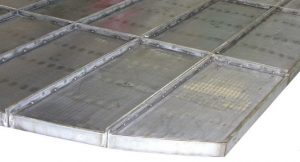 Support grids are a fundamental part of any reactor, sieve or other media bed application where the vessel is filled with catalyst, sieve beads or other media forming a bed which must be retained above the bottom of the vessel. The Wedge Wire Support Grid performs two primary functions, support for both the dead load (weight of the bed) and the live load (pressure differential during operation) and combines the precise wire and slot spacing forming a screen which prevents losses of costly media. Often due to the high cost and importance of the media for a process, designs for the wedge wire support grid is critical for proper media retention preventing media losses during operation.
Support grids are a fundamental part of any reactor, sieve or other media bed application where the vessel is filled with catalyst, sieve beads or other media forming a bed which must be retained above the bottom of the vessel. The Wedge Wire Support Grid performs two primary functions, support for both the dead load (weight of the bed) and the live load (pressure differential during operation) and combines the precise wire and slot spacing forming a screen which prevents losses of costly media. Often due to the high cost and importance of the media for a process, designs for the wedge wire support grid is critical for proper media retention preventing media losses during operation.
 Wedge Wire Support Girds are each a custom engineered design, not a commodity or off the shelf product. Designs must account for both the mechanical support for design load and select the correct wire type and slot sizes to result in correct open area to meet pressure drop requirements, all while fitting through a manway in segments for installation. To meet the design load requirements the support grid uses bolting bars for connecting each segment inside the vessel, bearing bars between each bolting bar, and a banding bar around the periphery, all which set the framework for the wire and rods to be fixed. All parts of the support grid from the smallest wire to the longest bolting bar must be designed to handle the design load to prevent collapse or failure. Slot sizes are custom per a customer’s requirement or based on media particle size and can range in size down to approximately 100 microns, or 0.004".
Wedge Wire Support Girds are each a custom engineered design, not a commodity or off the shelf product. Designs must account for both the mechanical support for design load and select the correct wire type and slot sizes to result in correct open area to meet pressure drop requirements, all while fitting through a manway in segments for installation. To meet the design load requirements the support grid uses bolting bars for connecting each segment inside the vessel, bearing bars between each bolting bar, and a banding bar around the periphery, all which set the framework for the wire and rods to be fixed. All parts of the support grid from the smallest wire to the longest bolting bar must be designed to handle the design load to prevent collapse or failure. Slot sizes are custom per a customer’s requirement or based on media particle size and can range in size down to approximately 100 microns, or 0.004".
In some applications where a large pressure differential for back flow or regen cycle could cause an uplift of the media and support grid, L-Bolts can be included on each segment. L-Bolts secure each segment to the vessel weld ring to prevent lifting of the support grid. Rope packing is also used to wrap around the periphery of each grid to prevent media bypass along the vessel wall.